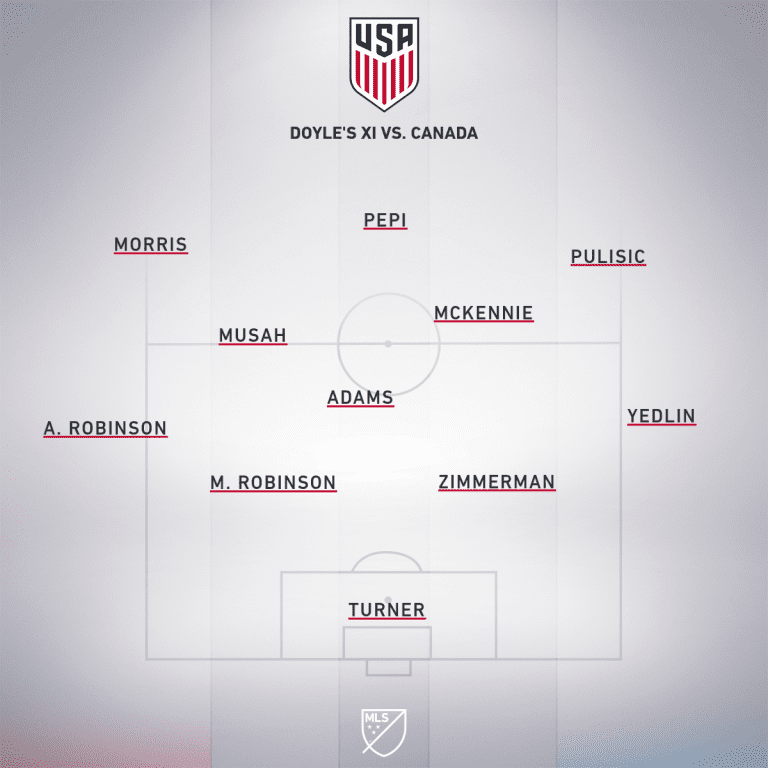On the pregame Twitter Spaces, ahead of the eventual 1-0 US men’s national team win over El Salvador in a World Cup qualifier on Thursday night, Andrew Wiebe asked me what I wanted to see from the US. What would, in his words, “spark joy”?
I said something to the effect of “I want them to show the ability to create repeatable, high-level chances based upon well-drilled and purposeful movement of, and off, the ball.”
And I kinda sorta got what I wanted. Lost in all the sturm und drang of the postgame analysis, which rightfully focused on the frustrations that led to a narrower-than-it-should-have-been victory over one of the Octagonal’s minnows (though full credit to Hugo Perez for infusing his side with such confidence and clarity in their principles of play that they never actually play like minnows), is that the US are now showing the ability to create those types of sequences. They really do, for the most part, know how they want to play. Most of them understand the system and apply it.
Here is well-drilled and purposeful movement of, and off, the ball from Weston McKennie, Jesus Ferreira, Sergino Dest and Tim Weah:
It’s just a little bit too slow and a lot too sloppy, and there is one run missing (more on that in a bit), but the ideas are there.
Here is a similar sequence in the second half:
The difference is that Weah makes an early run to create both width and depth – those clipped balls over the top were a nightmare for La Selecta all night, and I’m mad the US didn’t hit more of them – but it still results with the US getting the match-up they want in the channel they want, and this time it has a happy ending because the extra run, the one that was missing in the above sequence, was made.
If you think this can only work against El Salvador, here is a fun sequence vs. Mexico:
It was, once again, something similar on the first goal vs. El Tri:
This is how the US want to play, and how they are quite often playing these days. They have, for the most part, bought into how Gregg Berhalter sees the game, even if they don’t always execute on it.
It has only rarely sparked true joy for me, though, and almost not at all on Thursday. Let’s go back to my answer above: “I want them to show the ability to create repeatable, high-level chances based upon well-drilled and purposeful movement of, and off, the ball.”
That is the right answer, but it is not the complete answer. The complete answer is “I want them to show the ability to create repeatable, high-level chances based upon well-drilled and purposeful movement of, and off, the ball, and to do so at pace.”
The US, for whatever reason, often progress the ball at a walk and are slow to exploit advantages even when they’re right there for the taking. Berhalter said as much at halftime, telling ESPN’s Sam Borden: “We need to play forward a little bit quicker – we win the ball, there’s space. Second thing is we need to threaten their backline. Every time we do that we’re dangerous. We just haven’t done that enough.”
Berhalter is uncannily good and honest in those halftime interviews. He always nails the exact issues the US were struggling with during the first half, and almost always fixes it for the second half.
I do not think he’s saving this wisdom for the players for halftime. I’m certain he wants them to execute the above at pace from the whistle, and to be fair, the game’s best chance (Ferreira’s missed tap-in) came from a very good, very familiar sequence. They really can do it before the clock hits the hour mark.
But usually, they don’t. And almost never for the full 90. It is weird, and it is frustrating, but perhaps this is just the mark of a young, inexperienced team that's had to battle more injuries and absences than the vast majority of the competition over the past six months.
Anyway, three points are three points, and the parts are in place to collect more over the next couple of games. They just have to do what they’ve already been doing, except faster.
I have made this point over and over again: When Christian Pulisic plays on the left wing of the 4-3-3, he never stretches the field. His first, last and at times only instinct is to come back to the ball, point at his feet, go inverted and try to dribble three guys. It’s like the weight of that No. 10 makes him think he’s got to be Messi out there. So he turns the ball over a frankly unacceptable percentage of the time – 15 turnovers on 30 touches in the first half on Thursday.
Worse than that, though, is that he clogs the middle and makes it harder for the US to build through the zones where they should be at an advantage. Here is the network passing graphic from the first hour of the game, just before Pulisic was subbed off:
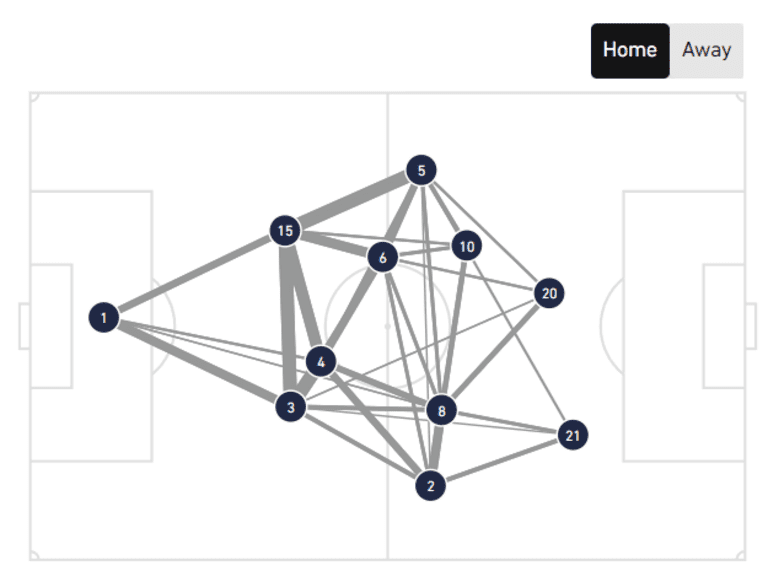
He’s added nothing when playing inverted like that, and actually ends up breaking the US shape in build-up by making the field smaller and pushing at least one (and sometimes two) of the US central midfielders out of the middle. El Salvador were playing a diamond, and with Pulisic checking deep like that, and Ferreira playing as a false 9, Yunus Musah had basically no choice but to drop deep and wide, basically outside of La Selecta’s defensive shape.
That renders Musah – the best US ball-progressor – ineffective by creating an overload in a pretty useless spot of the field, and puts Pulisic in a position where he’s just going to go into the hurt locker again and again and again. He’ll draw some fouls that way, but he’ll also turn the ball over a ton and what he’ll never do is create useful width or depth of the sort that Weah’s excelled at.
So above, when I said that “most of them understand the system and apply it,” there’s one guy I’m thinking of who just doesn’t seem to get it.
Here is the other concern from this night: Even when Pulisic was supposed to be inverted, he was slow to recognize patterns developing and thus didn’t threaten the El Salvador defense.
Let’s go back to the first clip above. Here is Ferreira dropping all the way off to help the build-up sequence and open space for Pulisic to attack the backline:
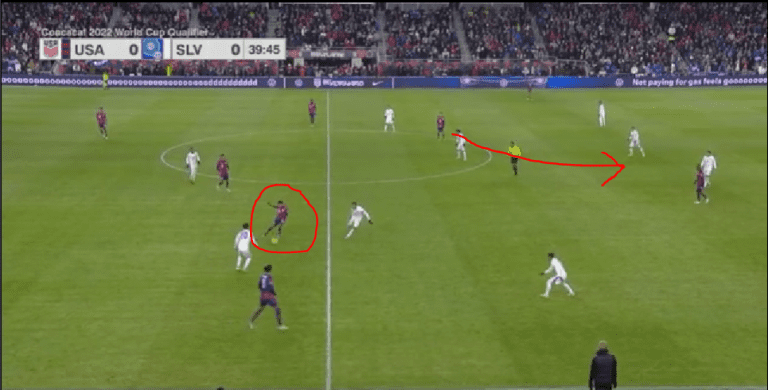
You know that the US are about to create a 2-v-1 with Weah and Dest, and that the left-sided center back is going to be pulled out. There is an opportunity here to get at a dead sprint against a backpedaling defense and just annihilate them.
He does not see it:
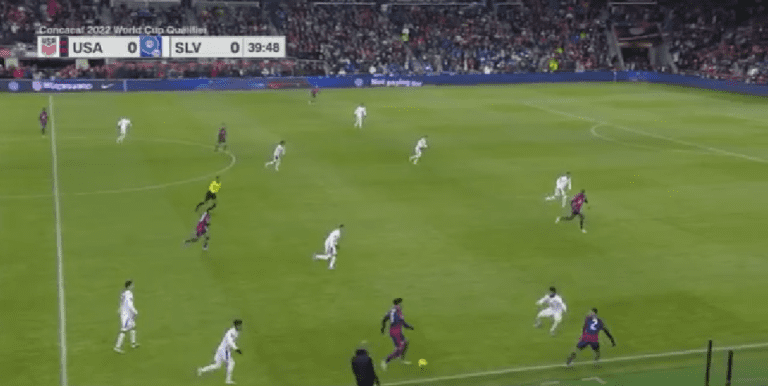
Everybody else in the US attack is sprinting, but Pulisic is standing still. Weah, McKennie, Dest and Antonee Robinson all get to the box before Pulisic does.
That is bad. This whole sequence is designed for Pulisic to get into the box and score the type of goal he scored vs. El Tri, but it just didn’t click for him. And while Dest’s touch was sloppy (scroll back up and watch the play again), I actually think that if Pulisic is making a hard run to either the near or far post, Dest would’ve just one-timed a low, early cross to him. There would’ve been no need for the extra touch that led to the turnover in the first place.
Go back and watch the goal sequence and you’ll see that Pulisic did better in his second-half cameo, and was in the six-yard box ready to pounce, having taken the space that Ferreira and Weah’s movement created.
But even if he’d scored there instead of Robinson, it would not have gone down as a good game from the guy who’s supposed to be the USMNT’s best player. And I really do think the solution can be as simple as having him and Weah (or Brenden Aaronson, or Jordan Morris) swap sides.
- Pulisic’s been more consistently dangerous throughout his career as a right winger. He can stretch the field just like Weah does, and is better 1v1 when getting the edge.
- Putting him on the right means that he can combine more with Dest, who is more inventive in attacking combination play than Robinson.
- Robinson always gets to the endline and loves to hit crosses to the far post. Pulisic is wonderful at attacking those exact types of crosses if that’s his main job out there.
- Weah has straight-up said that he prefers left wing to right wing, and while he will certainly come inside more than he has when playing on the right, I don’t think he’d ever do it to the gum-up-the-whole-works extent that Pulisic has.
So in the end it’s an argument for simplifying things for a guy who’s clearly one of the most talented players in the pool (I still think he’s the most talented player in the pool), but who also happens to be struggling with the system as a whole. Flip him to the right, flip one of the other guys to the left, and get him in front of goal.
I’m choosing to believe, from Berhalter’s postgame presser, that he’s seeing the same things I am:
“We put Brenden in, a guy who we know can repeat high-speed runs and really is relentless attacking their backline,” Berhalter said about subbing Aaronson on for Pulisic in the 65th minute. “So we thought it was a sub that was going to give us some help. Regarding Christain, it’s just about him finding his top form and really finding ways to get him in front of goal because that’s where he really shines. When he’s in front of the penalty box is when he does his best work.”
Amen. Move what pieces need to be moved in order to get him there.
• McKennie’s first half was maybe as good as I’ve ever seen him play, but his second half was sloppy as hell. A whole lot of El Salvador being on the front foot over the final 20 minutes came from McKennie just no longer commanding the game and giving the ball away too cheaply.
• Chris Richards really struggled with his decision-making over the first half-hour, repeatedly dribbling into traffic and failing to quickly see progressive outlets.
• I’d almost never choose to play with a false 9, and I think both Berhalter and Ferreira would quibble with designating Jesus as a “false 9” instead of just a regular No. 9 who has distinct attributes in this pool. But regardless, I do think the gambit showed promise. Ferreira dragged players around, was crisp in his passing and found two great chances.
Of course, it would’ve been nice if he’d finished one of those.
The downside to having Ferreira out there is that the US crossed the ball 23 times, and he is 5-foot-8. Ferreira’s good, but both from open play and especially on restarts, he is not an aerial threat. Even against El Salvador.
• Speaking of restarts, Pulisic’s dead-ball delivery was superb. The best the US have had it on set pieces in any of the qualifiers thus far.
• Tyler Adams was weirdly hesitant to be aggressive playing the ball forward. I can’t believe he didn’t release this pass as soon as it was presented, instead of holding on an extra beat and putting Aaronson in an offside position:
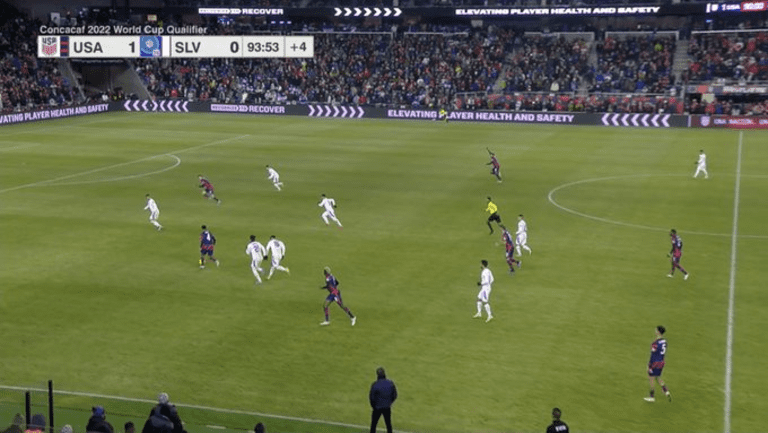
• StatsPerform clocked the xG on the night at 2.98-to-0.2 in favor of the US. That's a paddlin', and if Ferreira had finished either of his early chances, maybe the scoreline and overall feel of the game would've better reflected the underlying numbers.
But they didn't, and this is not the first time that's happened in qualifying. I'm not sure yet what this kind of consistent underperformance means, or if it means anything at all.
The Canadians will likely do something close to what they did against Mexico two months ago, constantly threatening in behind from both the wide areas and with balls over the top to either Cyle Larin or Jonathan David. This is also similar to how they played at the US back in September, though in that game they were much more content to play against the ball (they had just 25% possession) than I suspect they will be on Sunday.
The US should adjust almost nothing except making a few personnel changes. Miles Robinson in for Richards and either Reggie Cannon or DeAndre Yedlin for Dest. I’d start Pulisic on the right and Morris tucked in on the left, with Pepi in for Ferreira up top.
Just that, and tell them to do what they’ve been doing for a while now. And remind them to do it at pace.
